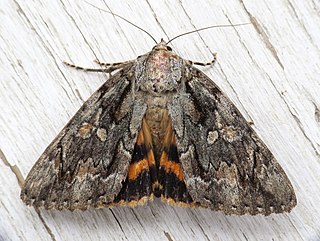
Catocala neogama, the bride, is an moth in the family Erebidae first described by James Edward Smith in 1797. It is found in North America east of the Rocky Mountains, from Maine and Quebec south to northern Florida and west to South Dakota, New Mexico, and into Arizona and Texas. Its westernmost population from the semiarid Colorado Plateau region is rather distinct and was once considered a separate species, but is now regarded as a well-marked subspecies C. n. euphemia.

Panthea gigantea is a moth of the family Noctuidae. It is found throughout much of the warmer and drier regions of western North America from south-central British Columbia, south to the state of Durango in Mexico and from the Black Hills of South Dakota, western Nebraska and the Texas Panhandle west to Washington, Oregon and the coast of California.

Raphia frater, the brother moth or simply the brother, is a moth of the family Noctuidae. It is found from Nova Scotia west, across the forested regions of Canada to British Columbia, south to Mississippi in the east. The southern limits in the west are uncertain due to confusion with several closely related species or forms.

Copablepharon grandis, the pale yellow dune moth, is a moth of the family Noctuidae. The species was first described by Strecker in 1878. It is found in North America from southern Alberta east to south-western Manitoba, the eastern parts of South Dakota, North Dakota and Iowa, west to California and south to southern Arizona, New Mexico and western Texas.
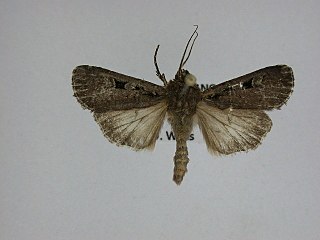
Euxoa tessellata, the tessellate dart or striped cutworm is a moth of the family Noctuidae. It is the most widespread Euxoa-species in North America. It is found from Newfoundland to Alaska, south in the west to California, Arizona, New Mexico, south in the east to Florida. It seems to be absent from Texas and adjacent eastern states.

Eudryas unio, the pearly wood-nymph, is a species of moth of the family Noctuidae. It is found in most of the eastern United States from central New Hampshire and southern Ontario, south to southern Florida. In the west it ranges to the eastern Great Plains, south to southern Texas and Veracruz along the eastern coast of Mexico. There are isolated populations in central Utah and California. The California population might be considered a distinct subspecies or even species, brevipennis.

Heliothinae is a small, cosmopolitan subfamily of moths in the family Noctuidae, with about 400 described species worldwide. It includes a number of economically significant agricultural pest species, such as Helicoverpa armigera and Helicoverpa zea.
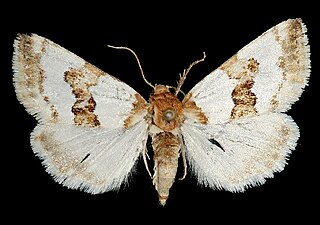
Schinia chryselloides is a moth of the family Noctuidae. It is found in Colorado from the base of the foothills in Jefferson County, east to Lincoln County, in extreme south-eastern Colorado, south to south-eastern Socorro County, New Mexico, and east to the south-eastern panhandle of Texas and extreme southern Texas.
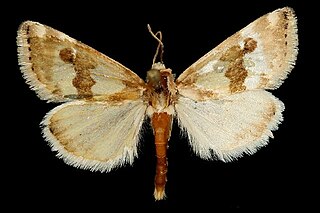
Schinia alencis is a moth of the family Noctuidae. It is found from south-eastern Colorado to south-eastern Arizona east to western Oklahoma, northern Texas to south-western and south-eastern Texas.
Psectrotarsia flava is a species of moth of the family Noctuidae. It is found in Peru, west of the Andes.

Psectrotarsia hebardi is a species of moth of the family Noctuidae first described by Skinner in 1917. It is found in the United States in northwestern New Jersey, southern Ohio, and western Virginia.
Psectrotarsia euposis is a species of moth of the family Noctuidae. It is found in several states around Mexico City.
Psectrotarsia rhodophora is a species of moth of the family Noctuidae. It is only known from Guatemala.

Hypotrix parallela is a moth of the family Noctuidae. It is found from south-western Colorado, southward through eastern Arizona, New Mexico, and western Texas to the State of Durango in northern Mexico.

Hypotrix spinosa is a moth of the family Noctuidae. It is a very rarely collected species that is known only from south-eastern Arizona, south-western New Mexico, and the State of Durango in northern Mexico.
Pseudomarimatha is a monotypic moth genus of the family Noctuidae. Its only species, Pseudomarimatha flava, is known from the western United States only in south-eastern Arizona and south-western New Mexico. Both the genus and species were first described by Clifford D. Ferris and J. Donald Lafontaine in 2010.
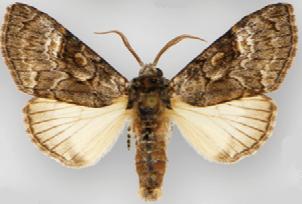
Charadra moneta is a moth of the family Noctuidae. It is found from central and eastern Arizona, the San Mateo Mountains of New Mexico, the Guadalupe Mountains of New Mexico and Texas, and the Big Bend region of Texas; south to the Sierra Madre in Nuevo León, northern Mexico.
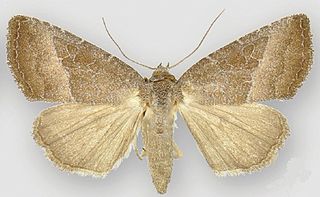
Ogdoconta cinereola, the common pinkband moth, is a moth in the family Noctuidae. It is found in eastern, central, and south-western North America. It occurs from southern Ontario and Quebec south to southern Florida. At the western edge of its distribution, it occurs from Manitoba southward through the Great Plains of Nebraska and Iowa, south throughout most of Texas, and westward through southern New Mexico to south-eastern Arizona. The distribution extends south to the state of Coahuila in northern Mexico.

Apantesis incorrupta is an arctiine moth in the family Erebidae, described by Henry Edwards in 1881. It is found from southern Colorado and south-eastern Kansas south through Arizona, New Mexico and western Texas into Mexico and west to south-eastern California. The habitat consists of grasslands and open woodlands.
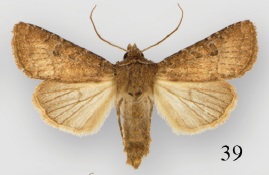
Protorthodes ustulata is a moth in the family Noctuidae first described by J. Donald Lafontaine, J. Bruce Walsh and Clifford D. Ferris in 2014. It is found in North America from south-eastern Wyoming southward to the Guadalupe Mountains in western Texas and westward to central and south-eastern Arizona and northern Mexico.













